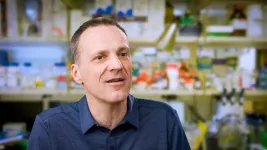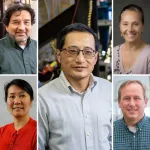(Press-News.org) A recent study has introduced a novel method combining nano informatics and machine learning to precisely predict cancer cell behaviors, enabling the identification of cell subpopulations with distinct characteristics like drug sensitivity and metastatic potential. This research could transform cancer diagnosis and treatment, enhancing personalized medicine by facilitating rapid and accurate testing of cancer cell behaviors from patient biopsies and potentially leading to the development of new clinical tests to monitor disease progression and treatment effectiveness.
In an important advance in the fight against cancer, a research team from The Hebrew University has developed a new method to predict the behavior of cancer cells with high accuracy. This innovative approach, combining nano informatics and machine learning, could revolutionize the diagnosis and treatment of cancer by allowing for the rapid identification of cancer cell subpopulations with varying biological behaviors.
In a novel study led by doctoral student Yoel Goldstein and Prof. Ofra Benny from the School of Pharmacy in the Faculty of Medicine, in collaboration with Prof. Tommy Kaplan, Head of the Department of Computational Biology at the School of Engineering and Computer Science at Hebrew University, The Hebrew University, an innovative method was developed to predict cancer cell behavior using nano informatics and machine learning. This discovery may lead to a significant breakthrough in cancer diagnosis and treatment, enabling the identification of cancer cell subpopulations with different characteristics through simple and quick tests.
The initial phase of the study involved exposing cancer cells to particles of various sizes, each identified by a unique color. Subsequently, the precise amount of particles consumed by each cell was quantified. Machine learning algorithms then analyzed these uptake patterns to predict critical cell behaviors, such as drug sensitivity and metastatic potential.
"Our method is novel in its ability to distinguish between cancer cells that appear identical but behave differently at a biological level," Yoel Goldstein elaborated and explained "This precision is achieved through algorithmic analysis of how micro and nanoparticles are absorbed by cells. Being capable to collect and analyze new types of data brings up new possibilities for the field, with the potential to revolutionize clinical treatment and diagnosis through the development of new tools."
The research has paved the way for new types of clinical tests that could significantly impact patient care. "This discovery allows us to potentially use cells from patient biopsies to quickly predict disease progression or chemotherapy resistance," stated Prof. Benny. "It could also lead to the development of innovative blood tests that assess the efficacy of targeted immunotherapy treatments as example."
Current tools for predicting and detecting cancer often lack accuracy and efficiency. Traditional methods like imaging scans and tissue biopsies can be invasive, costly, and time-consuming, leading to delays in treatment and potential misdiagnoses. These approaches may not capture the dynamic nature of cancer progression and can result in limited insights into the disease's behavior at a cellular level. Consequently, patients may experience delays in diagnosis, suboptimal treatment outcomes, and increased psychological distress. This highlights the urgent need for more effective and non-invasive diagnostic tools, like the recent breakthrough achieved by researchers at The Hebrew University, which represent a significant advancement in personalized medicine, providing hope for more effective and customized treatment strategies for cancer patients.
END
Breakthrough in cancer prediction with nano informatics and AI
Revolutionizing cancer treatment: A new predictive tool
2024-05-29
ELSE PRESS RELEASES FROM THIS DATE:
New immunotherapy could treat cancer in the bone
2024-05-29
A new type of immunotherapy, developed by UCL researchers, has shown promising preclinical results against a bone cancer called osteosarcoma, as part of a study in mice.
Osteosarcoma is the most common bone cancer in teenagers but is still relatively rare, with around 160 new cases each year in the UK. Meanwhile, more than 150,000 people suffer from cancer that has spread to the bones.
Cancer that starts in or spreads to the bones is particularly hard to treat, meaning that it is a leading cause of cancer-related death. ...
USC researchers pioneer new brain imaging technique through clear “window” in patient’s skull
2024-05-29
In the first study of its kind, researchers from the Keck School of Medicine of USC and the California Institute of Technology (Caltech) designed and implanted a transparent window in the skull of a patient, then used functional ultrasound imaging (fUSI) to collect high-resolution brain imaging data through the window. Their preliminary findings suggest that this sensitive, non-invasive approach could open new avenues for patient monitoring and clinical research, as well as broader studies of how the brain functions.
“This is the first time anyone had applied ...
Rahimi Wins CAREER Award for Electrochemical Carbon Capture Research
2024-05-29
HOUSTON, May 29, 2024 – Mim Rahimi, an assistant professor of civil and environmental engineering at the University of Houston, has received a National Science Foundation CAREER award for his research proposal focusing on liquid-liquid interfaces for electrochemical carbon capture research.
His research proposal is “Leveraging Liquid-Liquid Interfaces for Innovative Electrochemical Carbon Capture.” It was selected for $537,719 in funding, with research running through August 2029.
“The project ...
As racial diversity and income rise, civilian injuries by police fall
2024-05-29
An analysis of civilian injuries resulting from interactions with police in Illinois found that residents of all races and ethnicities are more likely to sustain injuries if they live in economically under-resourced areas. The risk of injury decreases as communities become more racially diverse, the researchers found.
The study from the University of Illinois Chicago analyzed information on nearly 5,000 injuries caused by police that were treated in Illinois hospitals between 2016 and 2022. The researchers then compared that information with socioeconomic data from the U.S. Census on each injured person’s home ZIP code. The study is published in the ...
Mason CARES intervention reduces stress and feelings of burden of family caregivers of older adults with dementia
2024-05-29
According to the U.S. Centers for Disease Control and Prevention, 80% of those living with dementia receive informal care from family members or friends. This equates to 16 million family caregivers in the U.S. However, caring for family members with dementia is often associated with increased caregiver burden (which includes emotional, physical, and financial strain), stress, and worse physical health for the caregiver.
A recent study published in the Journal of Applied Gerontology, led by George Mason University researchers, found that a 9-week online stress ...
Fatal attraction: When endangered species try to mate with domestic relatives, both wildlife and people lose
2024-05-29
Sticks and stones aren’t enough to thwart biological attraction, but sometimes those are the only tools available to pastoralists trying to prevent wildlife from eloping with their livestock.
A new study led by Colorado State University brings awareness to both the human impacts of these encounters – ranging from economic loss to death – and conservation concerns for the wild animals that are often endangered.
Conserving threatened and endangered species is a globally recognized priority, but justice and equity for the marginalized pastoralist populations around the world who experience conflict with these species are often ...
Mass General Cancer Center researchers present key findings at ASCO
2024-05-29
Leaders from the Mass General Cancer Center, a member of the Mass General Brigham healthcare system, will present research discoveries and outcomes from clinical trials in cancer at the 2024 American Society of Clinical Oncology (ASCO) Annual Meeting, held May 31-June 4, in Chicago.
ASCO brings together leading experts in clinical oncology to share the latest breakthroughs in cancer research, science and medicine. Presentations from Mass General Cancer Center investigators include a plenary session on palliative care delivery via telehealth versus in-person for patients with advanced lung cancer. Oral presentations ...
Experimental physics leads to award-winning research
2024-05-29
NEWPORT NEWS, VA – Physicist Holly Szumila-Vance has always been curious about how the world works. Throughout her career, she has never been afraid to tackle new and tough challenges to satisfy that curiosity. In doing so, she has helped reveal new details of how the ubiquitous proton interacts with the strong force inside matter.
Now, her work to reveal the nature of matter at the U.S. Department of Energy's Thomas Jefferson National Accelerator Facility has just won special recognition: the prestigious 2024 Guido Altarelli Award – Experimental ...
Could a medicated foam make gene therapies more accessible?
2024-05-29
SEATTLE — May 29, 2024 — Foam mixed with medications is already used to treat conditions such as varicose veins, hemorrhoids, wounds on the skin and even hair loss. Now, Fred Hutch Cancer Center scientists have found that foam might also be used as a vehicle to deliver expensive gene therapies.
Published May 28 in Nature Communications, bioengineer Matthias Stephan, MD, PhD, and his Fred Hutch team report that a foaming liquid worked better than a standard liquid formulation at transferring gene therapy components to cells in laboratory studies.
“Gene therapies are the new wave of medicine, but they are extremely ...
Lehigh University researchers secure $2.5M DOE grant to characterize, extract rare earth elements from utility waste
2024-05-29
The waste generated by power generation utility companies could be a potential source of metals and minerals that are key components of modern electronics, batteries, vehicles, and the clean-energy industry as a whole.
Zheng Yao, principal research scientist within Lehigh University’s Energy Research Center (ERC), and a multidisciplinary team of researchers recently received a $2.5 million grant from the Department of Energy (DOE) to identify rare earth elements (REEs) and elements of interest (EOIs) in wastewater and solid waste streams, and to develop the technology that could extract those elements.
The project team includes ...
LAST 30 PRESS RELEASES:
Heart-brain connection: international study reveals the role of the vagus nerve in keeping the heart young
Researchers identify Rb1 as a predictive biomarker for a new therapeutic strategy in some breast cancers
Survey reveals ethical gaps slowing AI adoption in pediatric surgery
Stimulant ADHD medications work differently than thought
AI overestimates how smart people are, according to HSE economists
HSE researchers create genome-wide map of quadruplexes
Scientists boost cell "powerhouses" to burn more calories
Automatic label checking: The missing step in making reliable medical AI
Low daily alcohol intake linked to 50% heightened mouth cancer risk in India
American Meteorological Society announces Rick Spinrad as 2026 President-Elect
Biomass-based carbon capture spotlighted in newly released global climate webinar recording
Illuminating invisible nano pollutants: advanced bioimaging tracks the full journey of emerging nanoscale contaminants in living systems
How does age affect recovery from spinal cord injury?
Novel AI tool offers prognosis for patients with head and neck cancer
Fathers’ microplastic exposure tied to their children’s metabolic problems
Research validates laboratory model for studying high-grade serous ovarian cancer
SIR 2026 delivers transformative breakthroughs in minimally invasive medicine to improve patient care
Stem Cell Reports most downloaded papers of 2025 highlight the breadth and impact of stem cell research
Oxford-led study estimates NHS spends around 3% of its primary and secondary care budget on the health impacts of heat and cold in England
A researcher’s long quest leads to a smart composite breakthrough
Urban wild bees act as “microbial sensors” of city health.
New study finds where you live affects recovery after a hip fracture
Forecasting the impact of fully automated vehicle adoption on US road traffic injuries
Alcohol-related hospitalizations from 2016 to 2022
Semaglutide and hospitalizations in patients with obesity and established cardiovascular disease
Researchers ‘listen in’ to embryo-mother interactions during implantation using a culture system replicating the womb lining
How changing your diet could help save the world
How to make AI truly scalable and reliable for real-time traffic assignment?
Beyond fragmented markets: A new framework for efficient and stable ride-pooling
Can shape priors make road perception more reliable for autonomous driving?
[Press-News.org] Breakthrough in cancer prediction with nano informatics and AIRevolutionizing cancer treatment: A new predictive tool






